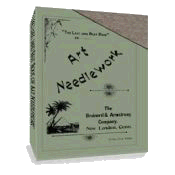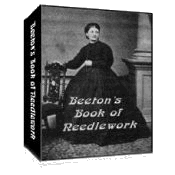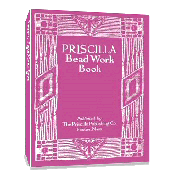More Stem Stitches
You Should Know About
More Stem Stitches You Should Know About is Part 4 of "How to Embroider Flower Stems."
RUGGED OR THORNY STEMS
Stems which are rugged or thorny, such as apple blossom boughs and rose stems Colored Plate 1 – STEMS, F and G, may also be most expressively embroidered in a suggestive way, by methods little more elaborate. To embroider these just as they should be, the worker is urged to use a frame or hoop, for in no other way can the best work be done. Before the work is mounted, however, outline in the hand the two edges of the apple bough for instance, in two shades of brown, one light, the other dark. Now break the regular edges by laid stitches, one-eight and one-fourth of one inch long, placed parallel with the direction of the stem and extending beyond the straight edges to indicate the bud scars and unevenesses of the branch (See Illustration C below). In the open space between the lines, lay these straight stitches in an irregular fashion, keeping the high light or uncovered linen pronouncedly toward the center Colored Plate 1 – STEMS, F.

Click on picture to see more detail.
Work the rose or any thorny stem in a similar way, so far as the outline of the stem goes. The thorns should be laid with stitches taken from within the space or width of the stem out to their points (See Illustration D).

Click on picture to see more detail.
Lay the first stitch directly to the point of the thorn; the next should commence a little below the start of the first and should finish up against the first, but should not be as long; the next, still shorter, placed in the same way, below the second. Two or three more stitches will finish the thorn from the bottom, and others should be placed above in the opposite direction, slanting down to meet the first or central stitch. The thorns along the edges thus worked will be very sharp looking. Those which are on the front of the stem as at “a” in Illustration D, should be laid in the same way, the central stitch placed first. If the “Asiatic” Filo is split for the filling-in work on the thorns, the effect will be even better. Colored Plate 1 – STEMS, G.
It is very interesting to work out stems in this sketchy way, and the result is very artistic. You can model them so to your liking, if you have the freedom, so to speak, insured to you in a stretched firm surface. Illustrations C and D show this work in the stems of roses and apple boughs and Illustration F shows another pretty and effective bit of work on the oak branch.

Click on picture to see more detail.
One stem grows out from another and it should therefore not appear to be added on. By using an “Overlap Tapestry Stitch” at the intersections, much strength and spirit may be put into these intersections. Colored Plate 1 – STEMS, C.
Easy Alternative
to Stitch Tree Trunks, Limbs and Twigs
This information was graciously submitted by Elizabeth L. This method seems to be remarkably effect and yet easy. Give it a try!
I have used a particular stitch to do tree trunks, limbs, and twigs that others might be interested in along with the ones in this month's newsletter. I think Victorian ladies would have used it on their own as it is simple to do.
I used a chain stitch, closed and in a filling manner. First, I went up on side of the area with the chain, then turned the fabric and went back down slightly overlapping the first row of chain. I repeated the third row in the same manner as the first row. Repeat the fourth row in the manner of the second row, etc. For a branch, limb or twig, just use less rows of filling chain stitch.
I used a variegated color thread; the one color ranging from pale to dark. By stitching every other row upside down and overlapping the stitch, a rough texture was achieved and the colors were placed in a natural juxtaposition to each other. My thread was a silk from Europe and gave a sheen here and there along the areas.
The chain used as filling has been used in English needlework for centuries, both before and after Victorian times; using mainly the wools and cotton supplies one could purchase then.
Elizabeth
TWISTED OUTLINE STITCH
Another very adaptable method for working stems, either in full or half work, is the twisted Outline Stitch Colored Plate 1 – STEMS, E. This can be done only on a framed fabric. The needle is brought up its full length above the surface, the silk, one or more strands, is twisted by turning the needle until the silk will coil up if let loose; with this twisted thread, lay a stitch one-quarter of an inch long on the line of the stem. Continue these, taking each one about one-third back on the one already laid and all on the same side as in Simple Outline.
The question has been asked, if it will not do as well to take long stitches in “Kensington Outline” Stitch with one of the twisted flosses. Certainly not — the result is totally different. The twisted floss would lie in loose stitches, whereas, if the filo is twisted as one works, it gains a certain spring, or tendency to uncoil, which makes it hold close to the ground material. Stitches of Twisted Silk in no way suggest the effect of “twisted outline work.” Illustration F shows in the arbutus the very satisfactory results of working ribbed stems in this way. Colored Plate 1 – STEMS, J. Stems may be shaded in rows of color, or two lines may be laid down each side of a stem, leaving the ground material between. One row of this work is not so effective or firm as two or more, and is seldom used except for veining leaves. The stitch is very effective in the stems of solid embroidery, on rich materials, silks, etc. See Colored Plate 1 – STEMS, I. It is in this case, of coarse, laid “solid” and two or more strands of filo may be used together. (See Illustrations. G and H below.)

Click on picture to see more detail.

Click on picture to see more detail.
TAPESTRY STITCH
Further, as to embroidered stems, which are supposed to suggest the natural ones, it is necessary to describe the very beautiful work which may be done in Tapestry Stitch. This is full work in the entire sense of the word. The stems so embroidered must be shaded so as to appear round, the work actually done, not suggested. The Tapestry Stitch is rows of Long and Short Stitch, laid parallel and lapping well over each other (See Illustration I below). The Worker using this means has every advantage of method for carrying out her idea completely. This is the only way a complete “filling in” of a stem should be undertaken in solid embroidery which is not absolutely conventional, except the Twisted Outline Stitch.

Click on picture to see more detail.
LAID STEM STITCH
The Laid Stem Stitch is the most important of the stem methods of purely conventional work and the most abused in its application. This, like most of the so called " French Laid Work," is a Satin Stitch, or one laid from side to side of a form, completely covering it in a mechanical fashion. In its perverted use, it might be called "Wrap Stitch." It is the ungainly "over and over," and it is absolutely distressing to see it coving flower stems, and yet one sees it constantly in amateur work. There is only one thing worse, and that is a painted stem on an embroidered flower. It is not possible to graduate the widths of a stem by this means, and it is difficult to keep the outline. A stem so worked looks like a jagged, stiff, characterless nothing, and no needleworker should allow herself to so spoil the effect of the rest of her work.
This work has its place. Stems, bars and lines, in connection with other laid work or French cottonwork, should be so embroidered, The work is admittedly mechanical, and must be done in perfectly regular way to be consistent, Lay the stitches from side to side, on a thread of the woof or warp as far as possible. If the stem is to be raised, the filling must be done with great care, for the evenness of the covering is dependent upon this. It is a pleasure to see the underfilling of the worn antique embroideries. Some of the Italian pieces of the Sixteenth Century, which show this where the over work is off, are a practical lesson. Lay the first stitch of the filling through the centre, parallel with the direction of the stem; then cross this with slanting stitches from side to side, taken just within the outline. Recross these with others from side to side, at the opposite angle. This last series should bind in all the stitches, and a firm filling, higher in the centre than at the sides, should be the result. All these steps of the underfilling work are shown in Illustration J.

Click on picture to see more detail.
Cross the filling with straight stitches, that is stitches at right angles with the direction of the stem, — always at right angles, never at a slant. This is carrying out the mechanical idea. Colored Plate 1 – STEMS, A.
OTHER CONVENTIONAL STEM STITCHES
Other conventional stemming may be done in the various couchings. Lay the heavier silks on the stem lines and couch them down with fine over-stitches. Beautiful work can thus be accomplished, but it is not practical for linens which are to be washed (See Illustration K).

Click on picture to see more detail.
Bulgarian Stitch, already referred to, is pretty and strong for conventional stems (See Illustration L below).

Click on picture to see more detail.
Stem Stitch and Split Stitch are also rather, stiff in effect, but sometimes they can be used to advantage in graceful lines. Split Stitch is serviceable in very fine work (See Illustration M below).

Click on picture to see more detail.
The spaces between the stitches of “Stem Stitch” saves it from being the nondescript “over and over.” It is pretty in scroll work (See Illustration N).

Click on picture to see more detail.
The Overlap Stem Stitch is a very convenient method for working the stems in scroll designs. It can be carried round a complete circle with perfect smoothness (See Illustration O).

Click on picture to see more detail.
Illustration P shows the stem of the Fleur-de-Lis, or Iris, which is sheathed. These sheathes should be worked out in Long and Short Stitch, and

Click on picture to see more detail.
The sections of the stem, where it shows, should be outlined. (Colored Plate 1 – STEMS, D.)
A general statement may be made in regard to stems. They should nearly always be embroidered in the direction of their length and not cross-wise their width. We can give a very satisfactory reason for this from nature: — The texture of most stems is “up and down,” so to speak. Such an exception occurs in our work, as the stem of the Moss Rose (See Illustration Q below), but this is readily explained by the fact that the moss, which covers the stem entirely, is horizontal. The stem itself does not appear. Horizontal stitches, crossing through the centre of the stem, best express this. One side may be green, the other brown.

Click on picture to see more detail.
Quite different from this is the hairy stem of the poppy. (See Illustration R.) Stems of this sort should be outlined first, either Simple or Twisted Outline, and the first lines of the fuzz laid completely over from side to side, at the proper angle. Colored Plate 1 – STEMS, H. The “Asiatic” Filo should be split, and the stitch should be tight in order to seem very fine. On a sheer linen, it is necessary to be very careful about carrying the thread from one stitch to another for, as it is laid in the reverse side, so it is likely to show through.

Click on picture to see more detail.
It is hoped that the above will serve to impress upon the needleworker the importance of the stems to the success, as a whole, of her work. It is well not to emphasize details too much but, unless details are properly disposed of, they will emphasize themselves in an undesirable way.
By L. Barton Wilson(Editor’s note: Small changes have been made to Mrs. Wilson’s article to allow for online publication as well as ease of reading.)
Return to Part 1 Return to Part 2 Return to Part 3
Return to top of More Stem Stitches Page
Return to Embroidery Instructions page.
Return to Home page.



 433 pages!
433 pages!

